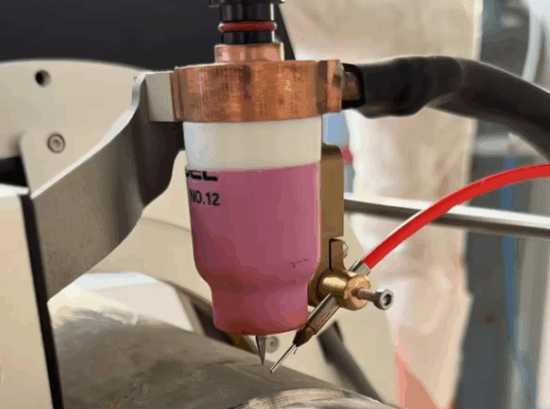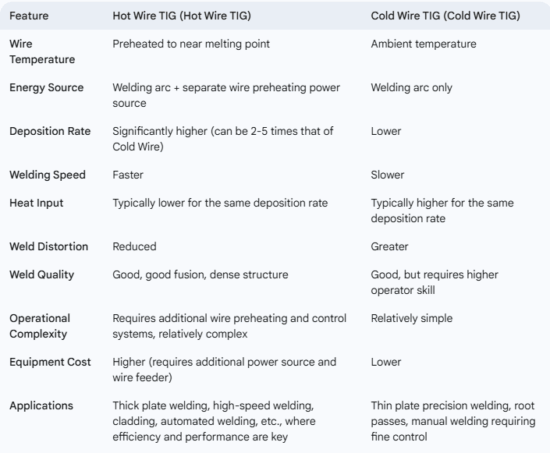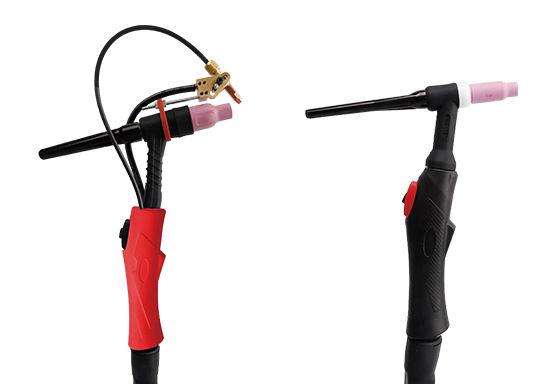Table of Contents
ToggleHOT WIRE TIG
In the relentless pursuit of high-quality and high-efficiency welding, technological innovation never ceases. Today, we’re going to delve into an advanced process that can significantly boost the efficiency and performance of TIG welding – Hot Wire TIG welding. What exactly makes Hot Wire TIG unique? And how does it demonstrate its powerful advantages in practical applications? Let’s explore.
I. Understanding the Hot Wire TIG Technique:
To understand Hot Wire TIG welding, let’s begin with its appearance. Unlike a standard TIG torch, a Hot Wire TIG torch has additional components. As shown in the image, it features a specialized wire feeder attached to the torch body. This feeder introduces the filler wire into the weld pool.
The Hot Wire TIG welding process involves melting a metal workpiece with the heat generated by a non-consumable tungsten electrode and the addition of a heated wire. The heated wire, typically made of the same material as the workpiece, contributes heat to the welding pool, enhancing productivity and ensuring consistent and high-quality welds. By regulating the wire feed speed and current, welders can achieve precise control over the heat input, arc stability, and weld deposition rates.

II. The Benefits of Hot Wire TIG Welding:
1. Enhanced Efficiency and Productivity:
By incorporating a heated wire, Hot Wire TIG welding significantly increases welding speeds and overall productivity. The controlled deposition of heat allows for faster travel speeds while maintaining excellent weld quality. Whether it is in shipbuilding, aerospace, or automotive industries, saving time without compromising precision is a paramount advantage.
2. Superior Weld Quality and Consistency:
Hot Wire TIG welding offers exceptional control over the welding process, resulting in welds of unparalleled quality. Consistent heat input ensures uniform fusion and reduces the risk of defects such as cracks, porosity, and distortion. Welders can achieve precise heat management, minimizing heat-affected zones (HAZ) and securing immaculate welds.
3. Versatility and Wide Application:
Hot Wire TIG welding showcases its versatility by being compatible with a wide range of materials, including stainless steel, aluminum, nickel alloys, and titanium. This adaptability makes it a go-to choice for various industries, from petrochemical plants to nuclear power generation, where welding requirements can vary greatly.

III. Hot Wire TIG Welding Applications:
1. Pipe and Tube Fabrication:
Hot Wire TIG welding plays a vital role in pipe and tube fabrication across industries such as oil and gas, marine, and construction. Whether it is seamless or welded pipes, the enhanced speed and precise heat control facilitate the creation of reliable connections with superior integrity.
2. Power Generation:
The power generation industry, including nuclear and thermal power plants, relies on Hot Wire TIG welding to ensure optimal performance and safety. The exceptional control over heat input and minimized distortion help in the maintenance and construction of critical components such as steam turbine parts and pressure vessels.
IV. The Future of Hot Wire TIG Welding:
As technology evolves, so does the welding industry. Hot Wire TIG welding continues to thrive as cutting-edge advancements consistently improve its precision, efficiency, and ease of use. Innovations such as automated systems and robotic hot wire TIG welding are revolutionizing manufacturing industries, offering standardized and repeatable weld quality.
Hot Wire TIG welding has undoubtedly revolutionized the welding landscape, enabling welders to achieve efficiency, precision, and superior quality that were once unimaginable. With its ability to control heat input and enhance productivity, this technique has become a go-to choice across diverse industries. By investing in the right equipment and mastering the art of Hot Wire TIG welding, welders can conquer complex welding tasks and deliver exceptional results that withstand the test of time. So, embrace the power of Hot Wire TIG welding and unlock a world of endless possibilities in the welding realm!

